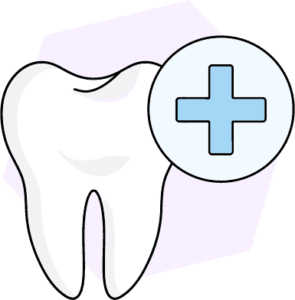Preventive dental care can detect, treat, and stop oral health problems like tooth decay and gum disease. There are multiple ways to practice preventative dental care. For example, you can brush your teeth and floss regularly to remove plaque and tartar and protect against diseases.
You can also visit the dentist for preventive dental care, which may include monitoring your oral health, detecting oral health problems, and treatments to prevent new diseases. At regular dental visits, dentists and hygienists evaluate your oral health, clean your teeth, and apply preventive treatments.
At a community-wide level, preventive dental care can include fluoridated water and broad-scale measures to encourage good oral health, such as encouraging people to stop smoking.
Table of Contents
The Importance of Preventive Care
In the U.S., tooth decay is the most common chronic disease among children and adults. Around 25% of adults between ages 20 and 64 have untreated dental caries, or tooth decay, which can lead to cavities.

Still, almost one-third of adults have not visited the dentist in the last year for a cleaning or exam.
Dentists use sealants to prevent cavities and take X-rays to detect and fill existing cavities. Left untreated, serious cavities can destroy the tooth’s root. Tooth decay can lead to expensive treatments such as a root canal, tooth extraction, and other oral surgery. One study found that Medicaid recipients without regular preventive dental care often incur significant costs due to emergency room visits, the need for oral surgery, and prescription opioid use.
Moreover, untreated oral health problems can lead to other issues beyond tooth decay. For example, gum disease is linked to other systemic diseases such as heart disease, diabetes, rheumatoid arthritis, and pregnancy complications.
How Insurance Coverage for Preventive Dental Care Works
Dental insurance typically covers 100% of the costs for preventive visits, which include cleanings, exams, and diagnostic services, such as X-rays. You can get dental insurance through private companies, your workplace, or government programs.
Some types of Medicare Advantage Plans may offer dental coverage as an extra feature, but preventive dental care is not covered by Original Medicare. Medicaid programs must cover dental services for children and youth under age 21 in all states. In 32 states, Medicaid covers preventive dental services for adults as well.
The Health Insurance Marketplace offers dental coverage both as standalone plans and as part of Marketplace health plans. Adult health plans purchased through Marketplace are not required to provide dental coverage, but plans for children must offer optional dental coverage.
Types of Preventive Dental Care
Preventive dental care includes daily at-home measures and semi-annual appointments with a hygienist or dentist.
Preventive Care at Home
At-home preventive care includes routine steps to care for your teeth and gums. These steps can prevent or halt the bacterial buildup and inflammation that can lead to or exacerbate tooth and gum diseases. At-home care typically includes the following:
- Brushing your teeth twice daily
- Using fluoride toothpaste
- Flossing along the gum line
- Avoiding or quitting smoking
- Keeping your mouth hydrated
- Maintaining a healthy diet
An electric toothbrush with a two-minute timer can help you brush more effectively.
If you have dentures, brush your dentures daily using a denture-care product. At night, soak your dentures in water or a liquid made specifically for denture cleaning.
Preventive Care at the Dental Office

Twice-annual dental visits can help keep your oral health intact. Routine dental appointments typically include:
- X-rays and physical evaluations to assess your tooth and gum health
- Screening for oral cancer
- Professional cleaning of your tooth enamel and gumline
- Fluoride treatments for your teeth
- Educational instruction on proper brushing, flossing, and use of other oral hygiene aids
- As-needed counseling on nutrition and quitting tobacco
You may also be able to get a sealant for your permanent molars’ top surfaces to prevent decay inside the teeth’s natural grooves. Your insurance company may or may not cover this treatment, depending on your plan and health status.
How Much Does Preventive Dental Care Cost?
Preventative care costs depend on your location, dentists’ services, and exam costs, but if you have dental insurance, it likely covers preventive dental care at 100%. You’ll only have to pay your monthly dental insurance premium. Your plan may cover a limited number of visits, treatments, and exams each year.
Without insurance, a routine adult preventive dental appointment, including a new patient exam, an X-ray, and a cleaning, generally costs between $400 and $600. An established patient visit could cost between $250 and $325.
Some dental and dental hygiene schools offer low-cost care clinics for those who cannot afford dental care. At these schools, qualified professionals supervise students in training who provide care. Community health centers and county or state health departments may offer income-based or low-cost dental services as well.
How To Schedule a Preventive Care Dental Appointment
If you do not have a preventative dental care routine, creating one might seem overwhelming. Follow the steps below to set up routine preventative dental visits.

- Find a dentist. Use your dental insurance search tool to find a dentist who will work with your plan. Or you can ask friends, coworkers, and neighbors for a referral to a gentle, patient dentist.
- Contact the dental office. Contact the dental office during office hours to schedule an appointment. Many dental offices only schedule by phone.
- Verify Insurance. Ensure the dentist takes your insurance and the preventive services are covered.
- Fill out the necessary forms. The office may ask you to fill out new patient forms ahead of your initial appointment. These forms will ask about your oral and general health and gather insurance and financial information.
- Attend the appointment. An initial preventive care appointment, which typically takes less than an hour, will include an exam, X-rays, a cleaning, and a meeting with the dentist. Depending on your insurance coverage, your visit may also include a fluoride application.
- Schedule future appointments and discuss a care plan. Based on the results of your initial preventive visit, your dentist will discuss how often you should return and whether any further home interventions or in-office treatments are needed.
What’s Not Considered Preventive Dental Care?
Some dental services can be essential due to disease or pain but are not covered as preventive care. Such interventions may include the following:
- Filling a cavity
- Root canal therapy
- Tooth removal and tooth implants
- Dentures
- Periodontal treatments for gum disease
- Orthodontics for misaligned teeth
Depending on your plan, your dental insurance may cover these treatments. However, most plans cover only a portion of the cost of treatment. Preventive care can help protect you from needing expensive dental treatments and procedures in the future.
All in All
Caring for your teeth now through at-home routines and dentist office visits can pay excellent dividends by preserving your smile, mouth function, and pocketbook. However, skipping at-home measures and appointments can lead to severe tooth and gum problems, which may require interventions that are not covered by your insurance plan.
In addition, poor dental hygiene and a lack of preventative care can lead to more serious systemic health issues. Take at-home and in-office approaches to maintain your oral and overall health.
